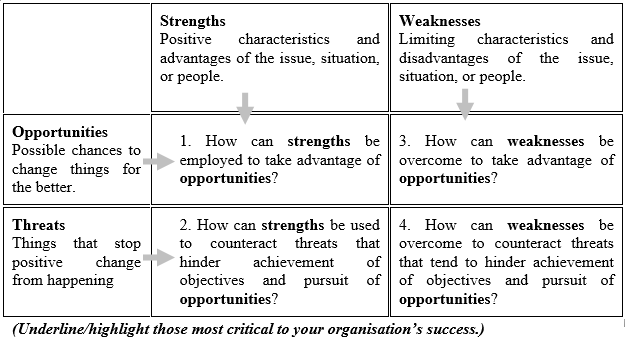
Category:
A Primary Tool
Description and Purpose:
The SWOT analysis is a commonly used matrix tool that can provide an objective and critical self-assessment as a background to strategic planning. SWOT stands for:
- Strengths
- Weaknesses
- Opportunities
- Threats
It looks at both the external and internal factors of an organization:
- Strengths and Weaknesses are internal to the organization.
- Opportunities and Threats are external to the organization.
This tool can deal with broad or narrow issues, as long as they are clear and understandable.
Method:
Draw a matrix that has nine fields (three rows and three columns). Label the fields as Strengths, Weaknesses Opportunities and Threats as shown below.
Participants begin by listing all strengths and weaknesses in the respective fields.
Strengths: Key strengths, core competencies/capabilities or (especially) unique advantages (‘Unique Selling Points’)
Weaknesses: Weaknesses in the organization – things it does less well and/or cannot cope with
Include aspects of skills and resources (see above).
This is repeated for opportunities and threats.
Opportunities: Opportunities that may arise for the organization
Threats: Potential threats to the organization and its work (From clients, from partners/competitors, from external environment)
In some circumstances, it may be more useful to substitute Constraints for Threats (making it a SWOC analysis).
Research and/or brainstorming can be used to generate the factors. If there is a facilitator, they can encourage discussion and analysis. The four empty fields of the matrix are completed using the following questions:
Participants identify major opportunities and threats that they believe the campaign will face (agree a timescale for this e.g. over the next 1-3 years). Then, select options for action and rate them according to their feasibility and potential benefit. Discuss the results and agree actions. Copy the matrix and leave original with the group.
In identifying strengths and weaknesses, it is essential that organization’s reflections are comprehensive and honest. The more truthful an organization is, the more it stands to benefit from the assessment process. Because each organization is different, criteria to be considered in the evaluation process should be determined by the organization.
Continuous self-assessment is critical for any group or coalition involved in an advocacy campaign. By identifying and analyzing internal strengths, a group will have a greater understanding of the attributes it possesses that can be used for the benefit of the campaign. Similarly, by acknowledging and evaluating weaknesses, groups can work towards improving weak areas, or amending their strategy so these are not needed.
Another option is to use the SOAR framework:
- Strengths
- Opportunities
- Achievements
- Results
This gives a positive analysis, where actions can be built on the basis of agreed strengths, achievements and results, taking account of opportunities in the external environment. This method is in line with the ‘Appreciative Inquiry’ methodology which seeks to apply and improve tried and tested methods, without demotivating.



